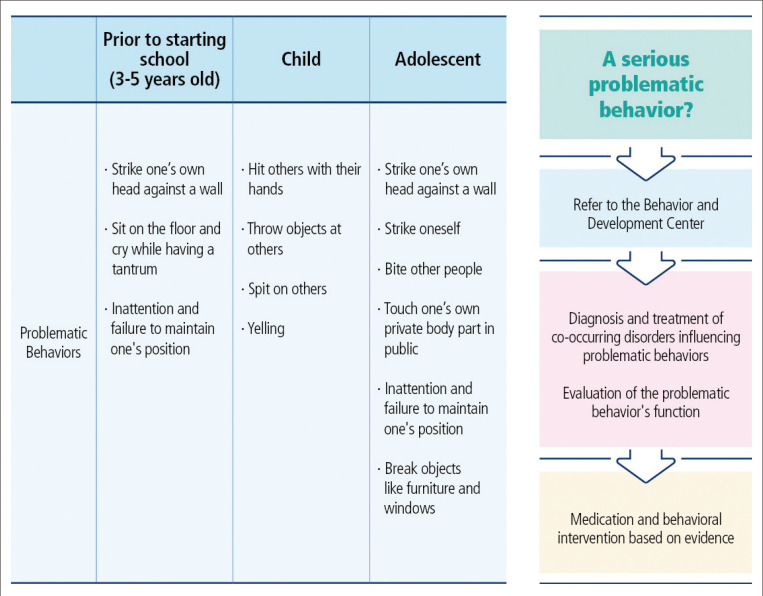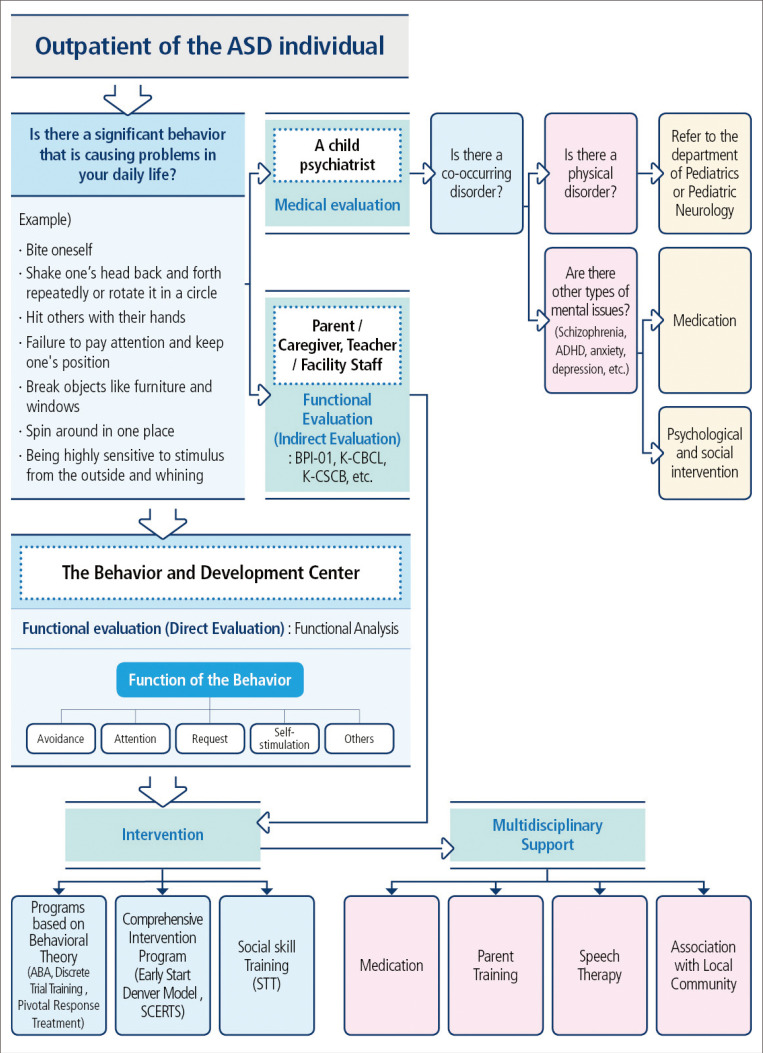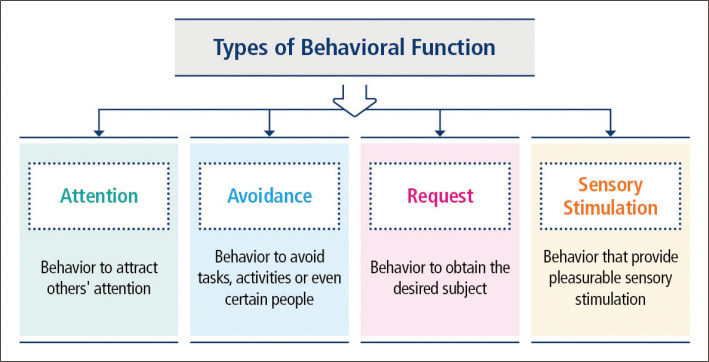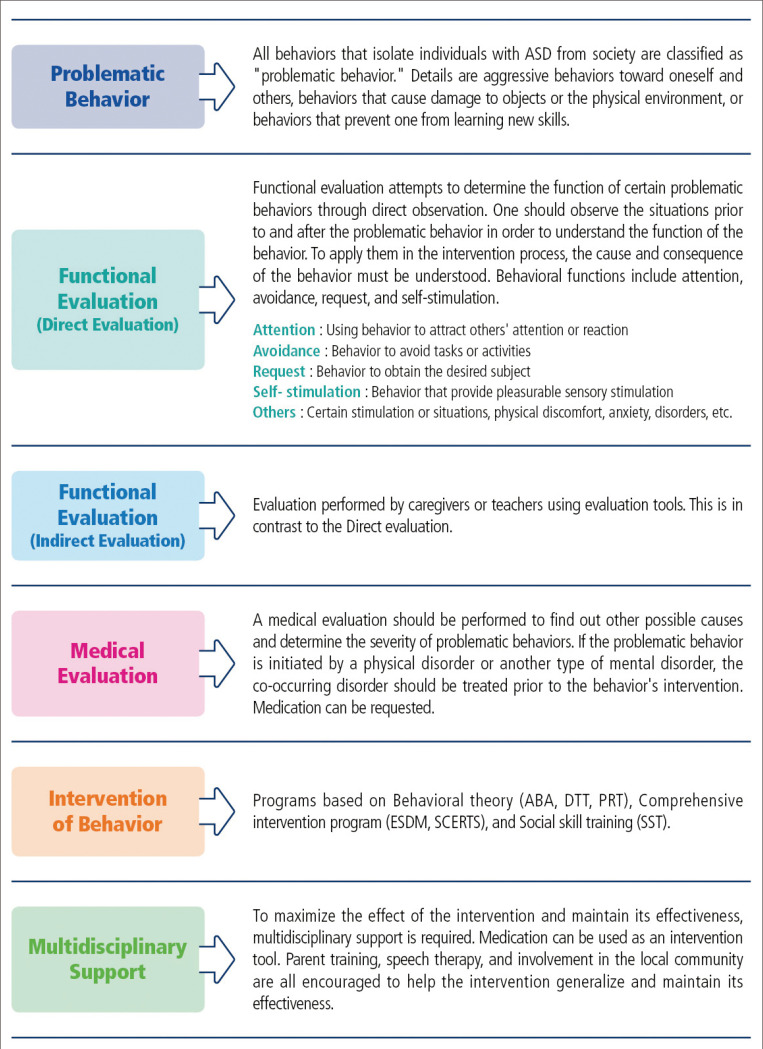Abstract
Parents of children with autism spectrum disorder (ASD) often encounter unique challenges when attempting to understand their children’s challenging behaviors such as self-injury, aggression, noncompliance, and stereotypies. In this study, we aimed to analyze and clarify the definition of challenging behaviors in individuals with ASD, identify the variables associated with challenging behaviors, and determine the function of these behaviors. Systematic observation and data collection are crucial to understand the functions of specific behaviors exhibited by individuals with ASD based on their antecedents and consequences. Knowledge regarding these will enable clinicians to develop and implement effective interventions. Additionally, the treatment approach should aim for generalization to improve the quality of lives of both children with ASD and their caregivers.
Keywords: Autism spectrum disorders, Problem behaviors, Behavior therapy, Parenting education
INTRODUCTION
More than half of individuals with autism spectrum disorder (ASD) experience one or more problematic behaviors. Some people interpret these as “challenging” behaviors [1]. However, these behaviors are more related to “behaviors that cause difficulties to oneself and caregivers, proving difficult to alleviate or resolve.” Such behaviors can pose threats to the psychological and physical well-being of children with ASD and their caregivers, acting as serious obstacles to studying, participating in social activities, and playing with others. Therefore, the educational and social opportunities for these children are limited because of such behaviors. Additionally, they affect and deteriorate the quality of life of both individuals with developmental disabilities and their caregivers [2].
Previous research has revealed that the interaction between “biological factors,” such as neurodevelopmental disorders, physical diseases, sleeping problems, and puberty issues, and “environmental factors,” such as sudden changes in surrounding conditions and reinforcement owing to caregivers’ reactions, contributes to the emergence of problematic behaviors [3]. Clearly defining challenging behaviors is crucial to implement efficient interventions and objectively evaluate corresponding behavioral changes. Additionally, intervention methods must be decided on the basis of the functions most associated with problem behaviors.
When encountering “challenging behavior” in individuals with ASD, evaluating whether the behavior is problematic is important. Observing and investigating whether the behavior deteriorates the quality of life and socialization, or threatens the person or their caregivers, is crucial. For example, taking one’s clothes off is not acceptable to the public but acceptable in a private space. Therefore, it is better to encourage the person to do so privately rather than trying to eliminate the behavior.
It is essential to refrain from defining unusual behaviors that may attract unwanted attention but provide considerable pleasure and pose no harm to oneself and caregivers as “challenging behaviors.”
These behaviors often become targets for extinction or treatment when labeled as such. It is crucial to present substitute behaviors to replace problematic ones. For example, if a child tears paper or clothes, healthy stimulation and extinction treatments should be implemented concurrently.
However, finding healthy stimulation that can substitute for challenging behaviors and satisfy children’s needs is challenging. In some cases, other stereotypical behaviors caused by the extinction of certain challenging behaviors are less socially accepted. If improving challenging behaviors is difficult, these behaviors might be used as a positive reward for continuing treatment. Figs. 1 and 2 provide a detailed breakdown of the aspects of challenging behaviors based on developmental stages, problem behavior evaluation, and treatment processes for serious challenging behaviors.
Fig. 1.
Problematic behaviors based on developmental stage. Kim BN and Kim YN. Guideline of Problematic Behavior Treatment for Children and Adolescents with Developmental Disorder. 1st ed. Seoul: Ministry of Health and Welfare;2018 [4].
Fig. 2.
A flow chart for the evaluation and intervention of problematic behaviors. Kim BN and Kim YN. Guideline of Problematic Behavior Treatment for Children and Adolescents with Developmental Disorder. 1st ed. Seoul: Ministry of Health and Welfare;2018 [4]. ABA, applied behavior analysis; ADHD, attention deficit hyperactivity disorder; ASD, autism spectrum disorder; BPI-01, Behavior Problems Inventory; K-CBCL, Korean version Child Behavior Checklist; K-CSCB, Korean Comprehensive Scale for assessment of Challenging Behavior in Developmental Disorders.
FUNCTIONAL EVALUATION OF CHALLENGING BEHAVIORS
When serious challenging behaviors that degrade one’s quality of life are discovered, the next step is to examine their causes. The National Institute for Health Care and Excellence (NICE) Guidelines of the United Kingdom [5] summarized these aspects:
• Communication issues hindering understanding or expression of one’s thoughts
• Co-existing physical problems such as pain and gastrointestinal disorders
• Psychological health issues such as anxiety and depression and co-existing neurodevelopmental disorders such as attention deficit hyperactivity disorder
• Sensitivity to one’s immediate environment, including noise and light
• Social environment, which includes family, school, and leisure activities
• Changes in everyday or personal life
• Developmental changes, including puberty
• Exploitation or abuse by others
• Careless reinforcements in dealing with challenging behaviors
• Absence of prediction and following countermeasures Functional evaluations are used to investigate the causes of challenging behaviors and their reinforcement because each behavior exhibited by children with ASD mostly has a certain “function.” These functions, when examined closely, are usually expressions of particular ideas. They can be a “request” or “dissent” to something or a means to draw some “attention.” Even sensory-stimulating behaviors can be considered as expressions of boredom. All of these behaviors become unnecessary when healthy communication is possible. Therefore, it is crucial to consider the circumstances under which challenging behaviors are used as communication tools (Fig. 3).
Fig. 3.
Types of behavioral function. Kim BN and Kim YN. Guideline of Problematic Behavior Treatment for Children and Adolescents with Developmental Disorder. 1st ed. Seoul: Ministry of Health and Welfare;2018 [4].
Effective intervention plans can be established when the function of the challenging behavior is clearly defined and when substituting behaviors or communication methods are identified. To determine the cause of an ongoing challenging behavior, one must critically understand the antecedents and consequences of the behavior through subjective observations and data collection. The ABC chart for analysis (Fig. 4) can be used to understand the functions of these behaviors.
Fig. 4.
ABC chart for behavioral analysis. Kim BN and Kim YN. Guideline of Problematic Behavior Treatment for Children and Adolescents with Developmental Disorder. 1st ed. Seoul: Ministry of Health and Welfare;2018 [4].
A: Antecedent - Events before the behavior, stimulation causing the behavior
B: Behavior - Behaviors that are defined with observable terminologies
C: Consequence - Events or reactions immediately after the behavior that affect the later occurrence of the behavior
Distinguishing the following factors based on functional analysis of the behavior and the causes that stimulate the challenging behavior can aid in formulating a detailed intervention strategy:
• Environmental factors that seem to trigger the behavior
• Detailed intensity and frequency of the behavior
• Purpose of the behavior
• Consequences of the behavior (how the situation develops because of the behavior)
Certain challenging behaviors are observed only in school or family settings. Hence, training teachers and caregivers on how to observe such behaviors is critical because an appropriate strategy can only be established with a clear understanding of the function of the behavior. For example, when teachers or caregivers report challenging behaviors during the day, they should do so in a subjective and observable manner, detailing aspects such as the type of behavior (self-injury, violence, yelling, etc.), how strong it was, and the body part that was affected. Moreover, a detailed strategy for behavior observation should be established ahead of time with teachers and caregivers to decide where to report (notebook, calendar, cell phone memo, related apps, etc.), where to place the observation sheets, and whether to report immediately or record and report later.
ESTABLISHMENT OF THE INTERVENTION PLAN FOR CHALLENGING BEHAVIOR
After completing the functional evaluation of challenging behaviors, an intervention strategy should be established. Intervention strategies can be generalized to the everyday lives of children with ASD before they are implemented. The ultimate goal of enhancing the quality of life of children with ASD and their caregivers cannot be attained if challenging behaviors tend to become extinct during treatment sessions but persist in educational and familial contexts. Therefore, all treatments should always aim for generalization.
Below are the general principles of an intervention strategy according to the function of the problem behavior [4].
To attract others’ attention (behavior maintained by attention)
• When problem behavior occurs, withhold attention
• When problem behavior is absent, provide full and sufficient attention
To avoid tasks or activities (behavior maintained for avoidance)
• When problem behavior occurs, continue with the task and activity
• When problem behaviors are absent, educate or teach substitute behaviors to deliver appropriate expressions
To obtain the desired object (behavior maintained by request)
• When problem behavior occurs, do not provide what is desired
• When problem behaviors are absent, educate or teach substitute behaviors for appropriate expressions
To obtain sensory stimulation (self-stimulatory behavior)
• When problem behavior occurs, remove or reduce sensory stimulation, allow time, and leave the area
• When problem behaviors are absent, assign tasks, educate or teach substitute behaviors for improved play skills, and educate the child to understand places where privacy is permitted
Other behaviors owing to certain stimulations, situations, or diseases (other causes of behavior)
• When problem behavior occurs, separate from the cause of the behavior
• When problem behavior is absent, teach healthy anger management techniques
“Guideline of Problematic Behavior Treatment for Children and Adolescents with Developmental Disorder” (Fig. 5) provides additional details on the evaluation and strategy methods.
Fig. 5.
A flow chart for a multidisciplinary intervention process to address problematic behaviors in an individual with ASD. Kim BN and Kim YN. Guideline of Problematic Behavior Treatment for Children and Adolescents with Developmental Disorder. 1st ed. Seoul: Ministry of Health and Welfare;2018 [4]. ABA, applied behavior analysis; ASD, autism spectrum disorder; DTT, discrete trial training; ESDM, Early Start Denver Model; PRT, pivotal response treatment.
ELEMENTS OF EFFECTIVE PARENT TRAINING
Parents and caregivers are encouraged to participate in all treatment processes from the beginning to promote generalization. If caregivers are unaware of the procedures involved in therapy and how challenging behaviors are reduced and become extinct, generalization becomes challenging. When caregivers understand the principles of treatment, they can apply them in their everyday lives and prevent new challenging behaviors from appearing. The following topics should be discussed during parent training on the application of intervention strategies in everyday life.
Reinforcers
A reinforcer refers to anything that increases behavior.
• Basic reinforcers: food, drink
• Social reinforcers: compliment, hug
Reinforcers are most effective when physical and social reinforcers are combined with complimenting phrases like “good job” and “excellent.” Children’s interests should be reflected in reinforcement. Reinforcers should be provided to the child immediately after they exhibit the desired behavior. For efficient use of the reinforcer, it is important to maintain the reinforcer for continued effectiveness.
Deliberate ignorance
Deliberate ignorance refers to deliberately ignoring a child’s specific behaviors. When a child receives deliberate ignorance as feedback for problematic behavior, they may gradually lose interest in engaging in that behavior after exposure to unpleasant stimuli. For example, avoid making eye contact, looking at, touching, talking to, or displaying facial expressions of anger or surprise toward the child. It is advisable to maintain a neutral facial expression.
Potential challenge: It may take time to see the strategy’s effectiveness because frequent deterioration in behavior is observed.
Compliance
Children with ASD exhibit noncompliant behaviors for numerous reasons.
Increasing compliance behaviors through training entails the formation of new habitual behaviors.
Compliance can be achieved through the following four steps:
Step 1: Stand close to the child to draw attention.
Step 2: Instead of asking or requesting, instruct the child on what to do.
Step 3: Help the child with physical aid to follow your instructions.
Step 4: Immediately offer detailed compliments once the child complies with your directions.
If a child rejects physical assistance or becomes aggressive, direct the child to complete simpler tasks first.
Prompts
This method assists children with ASD in learning and establishing new skills.
Linguistic prompts
Caregivers tell children what they want to say. For example, when caregivers tell a child to sit on a chair, they say, “Sit down” first and then sit on the chair (modeling). The child can observe a behavior or skill and imitate it.
Physical prompts
These involve actual physical movements using hands or body so that the child can follow and execute them accordingly. This level of assistance can vary depending on needs.
Maintenance and generalization
Maintenance occurs when a child’s newly observed positive behavior is maintained. Intermittent reinforcement occurs when the number of reinforcements for a new behavior decreases over time. Generalization occurs under various circumstances or environments, and specific positive behaviors can occur in the same manner as in the treatment. This phenomenon implies that a specific positive behavior can be maintained in various settings and with various people. When newly adapted positive behaviors (skills) are reinforced in various environments, there is a high chance of promoting generalization. It becomes challenging to generalize the behavior when the existing environment significantly differs from the new environment without receiving new training.
Parental training extends beyond teaching parents how to respond to challenging behaviors appropriately. Training on managing actual threats in daily life also needs to be conducted. For instance, it can be highly risky if a child who commits violence against their mother sits behind her while driving. Detailed strategies such as always traveling with others, placing a shield between the front and back seats, or hiring taxis for special needs should be implemented to prevent this.
IMPORTANCE OF UNDERSTANDING CHALLENGING BEHAVIORS
The persistence of challenging behaviors can stem from various factors, including differences in family circumstances, intervention plans, and available resources. Consequently, there are major principles and targeted directions for addressing challenging behaviors; hence, each family faces unique challenges. Every intervention plan is individualized, and every participant, including the child with ASD, caregivers, and teachers, should be considered when establishing the intervention plan for generalization. Therefore, considering multiple factors is extremely difficult.
Challenging behaviors in children with ASD can worsen as they grow and develop more functions and as their ways of thinking, needs, and desire for independence grow. Challenges will never be resolved when these factors are misinterpreted as stubbornness or problem deterioration. Understanding children with ASD as individuals with their own intellect and attempting to construct appropriate countermeasures for the challenges they face are critical to their healthy lives. The most effective intervention is prevention, which includes understanding intentions and prearranging a secure environment. It is strongly advised that these measures should be discussed with an experienced therapist for children with ASD.
Footnotes
Availability of Data and Material
Data sharing does not apply to this article, as no datasets were generated or analyzed during the study.
Conflicts of Interest
The authors have no potential conflicts of interest to disclose.
Author Contributions
Conceptualization: Yeni Kim. Project administration: Bung-Nyun Kim. Supervision: Yeni Kim. Writing—original draft: all authors. Writing—review & editing: Yearin Kim.
Funding Statement
This study was supported by the Ministry of Health and Welfare, Behavior and Development Center, and the Headquarter of the National Autism and Developmental Disorder Centers.
REFERENCES
- 1.Murphy O, Healy O, Leader G. Risk factors for challenging behaviors among 157 children with autism spectrum disorder in Ireland. Res Autism Spectr Disord. 2009;3:474–482. doi: 10.1016/j.rasd.2008.09.008. [DOI] [Google Scholar]
- 2.Durand VM, Merges E. Functional communication training: a contemporary behavior analytic intervention for problem behaviors. Focus Autism Other Dev Disabil. 2001;16:110–119. doi: 10.1177/108835760101600207. [DOI] [Google Scholar]
- 3.Kim YN, Choi JH, Lee CH. Expert training program for developmental disability aggressive behavior intervention. Ministry of Health and Welfare, National Center for Mental Health; Seoul: 2018. [Google Scholar]
- 4.Kim BN, Kim YN. Guideline of problematic behavior treatment for children and adolescents with developmental disorder. 1st ed. Ministry of Health and Welfare; Seoul: 2018. [Google Scholar]
- 5.National Institute for Health and Care Excellence, author. Autism: the management and support of children and young people on the autism spectrum (NICE clinical guideline 170) National Institute for Health and Care Excellence; London: 2013. [Google Scholar]







